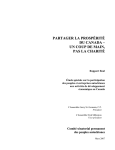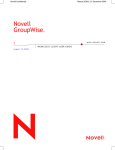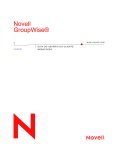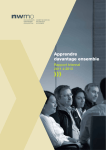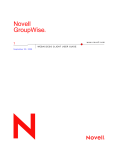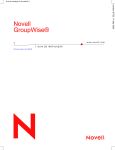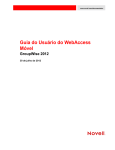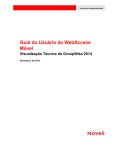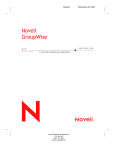Download GW7 WebAccess User Guide.pub - Northern Nishnawbe Education
Transcript
Novell GroupWise 7 WebAccess Reference Guide provided by the Northern Nishnawbe Education Council Technical Services Department Version 1.0 Table of Contents Starting GroupWise WebAccess................................................................1 Understanding Timing Out from GroupWise WebAccess ...............................1 Starting GroupWise WebAccess - Advanced Settings...................................2 Understanding the GroupWise WebAccess Main Window ..............................3 Understanding the Folder List ..................................................................4 Understanding the Item List ....................................................................5 Composing Items...................................................................................6 Sending a Mail Message ..........................................................................7 Managing Items You Receive ...................................................................8 Replying to an Item You Receive..............................................................9 Deleting Items You Receive.....................................................................9 Undeleting Items ................................................................................. 10 Forwarding a Mail Message.................................................................... 10 Using the Address Book ........................................................................ 11 Addressing an Item.............................................................................. 13 Managing a Personal Address Book......................................................... 14 Working with Attachments .................................................................... 17 Using Spell Checker ............................................................................. 18 The full GroupWise 7 WebAccess Guide as well as updates to this guide can be found at: http://www.nnec.on.ca/tech The GroupWise 7 WebAccess Guide can also be found online by clicking on the Help link on the WebAccess login page and following the Show link. For additional copies, or to report any suggestions or corrections please contact the Northern Nishnawbe Education Council’s Technical Services Department. Starting GroupWise WebAccess You start GroupWise WebAccess as you would any other home page on the Internet. Use your Web browser to go to the URL http://www.nnec.on.ca/gw/webacc, or http://www.nnec.on.ca and click on the Email link. User Name: Enter your user name exactly as the GroupWise system administrator entered it when creating your GroupWise account. Password: GroupWise WebAccess requires you to enter a password. This is your GroupWise Mailbox password not your Novell eDirectory password. The password is case sensitive. After you type in your username and password, click Login. For advanced settings, see Starting GroupWise WebAccess - Advanced Settings on page 2. Understanding Timing Out from GroupWise WebAccess Specific actions, such as opening or sending an item, generate a call to the Web server. Other actions, such as scrolling through items in the Item List, composing a message without sending it, or reading Help topics, do not generate a call to the Web server. If, for a period of time, you leave GroupWise WebAccess alone or perform actions that do not generate a call, WebAccess logs you out. Doing so not only provides security for your e-mail but also ensures that the Web server and GroupWise WebAccess run efficiently. The time-out period is determined by your GroupWise system administrator. If you try to perform an action after you have been logged out, you are prompted to log in again. NOTE:You must authenticate correctly to be returned to your work after a timeout. If you haven’t logged in correctly, the message may appear to be lost. Use the keyboard to return to your saved message window (for example, Alt + Left-arrow key in Windows) and try logging in again. -1- Starting GroupWise WebAccess - Advanced Settings From the Login Window, fill in the following information: User Name: Enter your user name exactly as the GroupWise system administrator entered it when creating your GroupWise account. Password: GroupWise WebAccess requires you to enter a password. This is your GroupWise Mailbox password not your Novell eDirectory password. The password is case sensitive. If you don't know your full name, user ID, or password, contact your GroupWise system administrator. Your user ID is the first part of you email address; for example, if your email address is [email protected], your user ID would be jdoe. Connection Speed: If Connection Speed is not displayed, click the Settings button. The settings are for the type of Internet connection type you have. • High (Broadband): The high interface has all the features that are available in GroupWise WebAccess. You should use Default if you have a high-speed internet connection. • Low (Dial-up): The low interface looks the same as the default interface, but it does not autoupdate the message list and the calendar. In addition, the low bandwidth interface does not support name completion. Use the Basic Interface: The basic interface is designed for mobile devices. There is limited functionality and graphics. The simple interface is designed to do the most basic tasks in GroupWise. Remember My Settings: If you use the same browser to log in to GroupWise WebAccess again, your preferences are saved. -2- Understanding the GroupWise WebAccess Main Window When you open GroupWise WebAccess, you see the main window, shown below. The main window is the starting point for many of the tasks you can accomplish with GroupWise WebAccess. The main window has different components to help you accomplish your daily tasks. The following sections describe the various components you can use from the main window: -3- Understanding the Folder List The Folder List displays the folders used to organize the items you send and receive. You can add additional folders to further help you organize your items. The Mailbox folder is the default folder that is opened when you first log in. The following folders are displayed in the Folder List. You can open a folder by clicking the icon. Icon Description Mailbox Lists items you receive. The Mailbox is a system folder. Unopened Items Lists received items you have not yet opened. Sent Items Lists items you send from the Mailbox and Calendar. The Sent Items folder is a system folder. After you move a sent item from the Sent Items folder to another folder, it no longer displays in the Sent Items folder. (In the previous version of GroupWise WebAccess, the Sent Items folder was a query folder that listed sent items from all folders.) Calendar Lists all appointments, tasks, and notes in your Calendar. The Calendar is a system folder. Checklist Lists items you have moved to this folder. Use the Checklist folder to create a task list. The Checklist folder is a system folder. (In the previous version of GroupWise WebAccess, a Task List folder listed all the task items in your Mailbox and Calendar. The Task List folder was a query folder.) Cabinet Lists folders you’ve created. The Cabinet is a system folder. Work in Progress Trash Lists items that have been saved to be sent later. The Work in Progress is a system folder. Lists deleted items that have not yet been purged. The Trash is a system folder. System Folders The folders listed in the table are system folders, which are created by GroupWise and cannot be deleted. Personal Folders You can add additional folders to further organize your items. For example, you could add a folder to your Cabinet to store all messages you receive regarding a specific project you are working on. Shared Folders You can share personal folders with other users. Recipients of the shared folder receive a notification explaining that you have shared the folder with them. They can then accept the folder or decline the folder. Find Results Folders In the Windows version of GroupWise, you can save the results of an item or document search in a folder. You cannot do this in GroupWise WebAccess. However, GroupWise WebAccess lets you view any Find Results folders you create in another version of GroupWise. -4- Understanding the Item List The Item List displays the contents of the folder that is currently open. By default, the most recent 20 items in the folder are displayed. If the folder contains more than 20 messages, a Display Next button appears at the bottom of the list. You can use it to display the next 20 messages, or you can choose to select more or less than 20 messages. The icon next to each item indicates the item type, status, and priority. You click an item to open it. You can drag and drop items to move them. When you open an item, all actions you can perform on that item type are displayed at the top of the item view. For easy access, actions that you commonly perform on items are also displayed at the top of the Item List. You can select multiple items by clicking the boxes to the left of the items. Whenever you select items in the Item List and perform an action on them, WebAccess updates the Item List. To refresh the list manually, open the folder again or click Update at the top of the list. The following icons can be displayed in the Item List: Icon Message Type, Status, and Priority Unopened mail message (high, normal, low priority) Opened mail message (high, normal, low priority) Unopened appointment (high, normal, low priority) Opened appointment (high, normal, low priority) Unopened task (high, normal, low priority) Opened task (high, normal, low priority) Unopened note (high, normal, low priority) Opened note (high, normal, low priority) Unopened phone message (high, normal, low priority) Opened phone message (high, normal, low priority) Reply requested (high, normal, low priority) Unopened document reference Opened document reference One or more attachments included with the item Shared folder notification Shared address book notification Sent item Unopened posted item (shared folder) Opened posted item (shared folder) -5- Composing Items GroupWise WebAccess has five different item types: mail message, phone message, appointment, note, and task. You address all item types in the same way, using the Address Book to add recipients’ addresses to the To, CC, and BC boxes. You can also attach files to each item type and include Web site locations (URLs) in the Subject and Message box of each item type. These five item types fit into three categories: unscheduled, scheduled, and posted items. Unscheduled Items: Unscheduled items include mail messages and phone messages. Both types of messages let you send a messages that are not scheduled for a particular time or date. - Mail Message: Lets you specify a subject and message. - Phone Message: Similar to mail messages, except that phone messages have boxes for caller, company, and phone number information. Scheduled Items: Appointments, tasks, and notes are scheduled items, meaning that they appear in the recipient’s Calendar as well as the Mailbox. The recipient of an appointment, task, or note has the option of accepting or declining it. Accepted items are removed from the recipient’s Mailbox and stored in the recipient’s Calendar. Declined items are removed from both the recipient’s Mailbox and the Calendar. If you are the sender, you can see what action recipients have taken by checking the status information for the scheduled item. - Appointment: Lets you include the time, date, and place of the appointment. You can use Busy Search to find times when all recipients are free. - Task: Lets you indicate which day you want the task to appear in the recipient’s Calendar and which day you want the task completed. You can also assign a priority to the task. - Note: Lets you indicate which day you want the note to appear on the recipient’s Calendar. Because notes are posted in the recipient’s Calendar, they are frequently used as reminders of specific events, such as days off, project deadlines, or birthdays. Posted Items: Posted items are scheduled items you create for yourself. They function like regularly scheduled items, but are placed directly in your Calendar. -6- Sending a Mail Message 1. In the GroupWise WebAccess main window, click New > Mail. 2. Click Address Book to add recipients in the To, CC, and BC fields. or Type a recipient’s address in the To, CC, or BC fields. When you begin typing a name in the To, CC, or BC fields of an item you are creating, Name Completion tries to complete the name for you. If Name Completion finds the name you are looking for, you can stop typing. If Name Completion doesn’t find it, continue typing: Name Completion searches again after each new character you type. If Name Completion finds a name that is close to but doesn’t exactly match the one you are looking for, you can use the Up- or Down-arrow to scroll to adjacent names in the address book. IMPORTANT:Name-completed addresses for all item types come from the Frequent Contacts book only. 3. Type a subject and message. You can include Web site locations or addresses (URLs) in both the Subject and Message boxes. 4. (Optional) Click Spell Check to check the spelling in the message. For this feature to work, your browser must be enabled for Java*. 5. (Optional) Click Attach to attach files to the message. For this feature to work, your browser must support attachments. 6. (Optional) Click Send Options to select a security setting (classification), assign a priority (high, standard, low), request a reply, or select to receive return notification. 7. Click Send. If a Web server outage occurs while you are composing a message, your message is not lost when you click Send. It is captured and appears at the bottom of the WebAccess Login page so that you can retrieve it when your Web server comes back up and you log into WebAccess again. -7- Managing Items You Receive Reading and managing mail messages, appointments, tasks, or notes in WebAccess is as simple as clicking your mouse to open the item. Opening an Item in Your Mailbox In WebAccess, all GroupWise items are opened the same way: in the Item List, click the subject of the item, or right-click it > click Open. The available buttons vary depending on the item type you have open. Appointments, tasks, and notes can be accepted, declined, or delegated; right-click an item > click Accept, Decline, or Delegate. You can also click Accept, Decline, or Delegate on the toolbar. Searching for an Item To perform a search for a specific item, you can either use the Find tool on the main window, or you can use the Search tool. Using Find 1. Type the word you want to search for in the Find field. 2. Click Find. The results are displayed in the message list. Using the Search Tool 1. From the GroupWise WebAccess main window, click the icon. 2. To search for specific text, click Full Text or Subject, then type the words you are looking for in the text box. 3. To search for a name, click From or To/CC, then type the name in the text box. 4. Select each item type you are looking for. If you select Document, Find searches your Mailbox for document references. 5. Select each item source you are looking for. 6. In the Search In list, click the folders you want to search in. If you are searching in a folder in the Cabinet, you might need to click the plus sign next to the Cabinet to display the Cabinet folders. If you select Mailbox, your Sent Items folder is included in the search. If you do not select a folder, all listed folders are included in the search. 7. Click Find. -8- Replying to an Item You Receive You can reply to an item you receive. You can reply to the item’s author or to everybody who originally received the item. 1. Click the Mailbox icon in the Folder List or Toolbar or Click the Calendar icon in the Folder List, then go to the date of the appointment, task, or note. 2. Click the message, appointment, task, or note to open it. or Right-click the item > click Reply. 3. Click Reply to Sender or Reply to All to open a Reply form. Reply to Sender sends a reply to the sender only. Reply to All sends a reply to the sender and all recipients of the original item. Choose whether to include the original message in your reply. 4. Type your message. You can include Web site locations or addresses (URLs) in the Message field. 5. Click Send. Deleting Items You Receive You can delete Items you receive and place them in the Trash. 1. Click the Mailbox icon in the Folder List. or To delete an item you have moved to a folder, click the folder in the Folder List. or To delete an appointment, task, or note you already accepted, click the Calendar icon in the Folder List or Nav Bar. 2. Locate the items in the Item List. 3. Select the items, then click Delete at the top of the Item List. or Click the item to open it, then click Delete. or Select the items and drag them to the Trash. or Select the items, right-click them > click Delete. The items are removed from your Mailbox or Calendar. The status of the items is also updated in the sender’s Mailbox or Calendar to show you deleted the item. As long as the items remain in your Trash, you can undelete them. -9- Undeleting Items You can undelete items you deleted (unless you have emptied the Trash). Items emptied from the Trash cannot be undeleted. 1. Click the Trash icon in the Folder List. 2. Select the items, then click Undelete at the top of the Item List. or Click the item to open it, then click Undelete. or Right-click the items > click Undelete, or Drag the items out of the Trash folder and drop them onto another folder icon. The items are moved from your Trash to the folder from which they were originally deleted. Forwarding a Mail Message 1. Click the Mailbox in the Folder List. 2. Click the mail message to open it. 3. Click Forward. or Right-click the item > click Forward. The original message is included as an attachment to the new message. 4. Click Address Book to add recipients in the To, CC, and BC fields. or Type a recipient’s address in the To, CC, or BC field. The address can be a GroupWise user ID, GroupWise full name, or external e-mail address. Separate each address with a comma. 5. Type a message. You can include Web site locations or addresses (URLs) in the Message field. 6. (Optional) Click Spell Check to spell check the message. For this feature to work, your browser must be enabled for Java. 7. (Optional) Click Attach to attach files to the message. For this feature to work, your browser must support attachments. 8. Click Send. - 10 - Using the Address Book The Address Book stores information about users, resources, and organizations. You can use the Address Book to search for information or to add e-mail addresses to an item you are composing. The Address Book consists of the GroupWise system address book, one or more personal address books, the Frequent Contacts address book, and possibly shared address books and LDAP address books. GroupWise System Address Book: You have one GroupWise system address book. The system address book includes all users who have a GroupWise Mailbox in your organization. You cannot modify the system address book. Personal Address Books: You can have multiple personal address books. By default, GroupWise WebAccess provides one predefined personal address book with your name as the title. You can use your personal address book to add e-mail addresses and information for users, resources, or organizations not defined in the system address book. Frequent Contacts Address Book: You have one Frequent Contacts address book. Your most frequently and most recently used addresses are automatically added to this book. Any recipients of items sent in the WebAccess client are added to the Frequent Contacts address book. In addition, addresses added by the Windows GroupWise client also appear in the GroupWise WebAccess Frequent Contacts address book. - 11 - Searching for an Entry in the Address Book 1. In the GroupWise WebAccess main window, click Address Book to open the Address Book. By default, the Address Book opens to the GroupWise address books. 2. In the Address Books list, select the address book you want to search. For GroupWise, you can choose from the GroupWise address book, the Frequent Contacts address book, or a personal address book. 3. Select the number of entries you want displayed at one time. The default displays 15 entries at one time. 4. To list the first entries (15 by default) in the selected address book, leave the search conditions boxes empty. or To search for a specific entry, click the icon to show another set of search condition boxes and the icon to hide all search conditions boxes. These boxes let you define the Address Book fields and information you want to search. GroupWise WebAccess supports the * (asterisk) and ? (question mark) wildcards. When searching a field, you can use * to represent multiple characters and ? to represent one character. If you define a “Last Name contains s?n” condition, the search returns all entries whose last names contain S and N separated by one character (Sanders, Johannson, Larsen, and so forth). 5. Click Search Address Book (or Search) to display a list of entries that match your search conditions. If you decide to send an item to a user you found, you can select a user, click To, CC, or BC to add the name to the recipient list, then click Mail to open a new item. NOTE:Double-clicking a user adds it to the To list. - 12 - Addressing an Item 1. Open a new item. 2. Click Address Book to open the Address Book. By default, the Address Book opens to the GroupWise address books. 3. In the Address Books list, select the address book you want to search. For GroupWise, you can choose from the GroupWise address book, the Frequent Contacts address book, or a personal address book. 4. Select the number of entries you want displayed at one time. The default displays 15 entries at one time. 5. To list the first entries (15 by default) in the selected address book, leave the search conditions boxes empty. or To search for a specific entry, use the search conditions boxes to define the Address Book fields and information you want to search. GroupWise WebAccess supports the * (asterisk) and ? (question mark) wildcards. When searching a field, you can use * to represent multiple characters and ? to represent one character. For example, if you define a “First Name begins with jo*” condition, the search returns all entries whose first names start with JO (John, Joel, Jose, and so forth). If you define a “Last Name contains s?n” condition, the search returns all entries whose last names contain S and N separated by one character (Sanders, Johannson, Larsen, and so forth). 6. Click Search to display a list of entries that match your search conditions. 7. Select the entry you want to add to the item’s recipient list, then click To, CC, or BC to indicate the recipient type. NOTE:You can double-click the name to add it to the To: list. 8. After you finish selecting the item’s recipients, click OK to add them to the item. - 13 - Managing a Personal Address Book You can have multiple personal address books. By default, GroupWise WebAccess provides one predefined personal address book with your name as the title. You can use your personal address book to add e-mail addresses and information for users, resources, or organizations not defined in the system address book. These addresses can be for people inside or outside of your organization. Creating a Personal Address Book 1. In the GroupWise WebAccess main window, click Address Book to open the Address Book. 2. Click Address Book Options. 3. Click Create to display the Create Address Book form. 4. In the Address Book Name field, type the name you want to use for the personal address book. 5. If desired, type a description in the Description field. The description is for your use only. It appears only when viewing the address books in the Address Books Options form. 6. Click OK to add the new address book to the Personal Address Book list. 7. Click Close to return to the Address Book. - 14 - Adding Entries to a Personal Address Book 1. From the GroupWise WebAccess main window, click Address Book to open the Address Book. 2. In the Address Book, click Add Entry to display the Add Address Book Entry form. 3. If you want to add a resource or organization rather than a person, click Resource or Organization. 4. Select the personal address book where you want to add the entry. 5. Fill in at least one of the asterisks fields. This is required so that the entry can be listed in the Address Book. If you want to send messages to the entry, make sure you complete the E-Mail Address field. 6. Fill in any other fields you want. Any information you add displays when you select the entry in the Address Book. 7. Click OK to save the entry to the selected address book. - 15 - Creating a Personal Group 1. In the GroupWise WebAccess main window, click Address Book to open the Address Book. By default, the Address Book opens to the GroupWise address books. 2. In the Address Books list, select the address book that contains the entries you want to add to the group. For GroupWise, you can choose from the GroupWise address book, the Frequent Contacts address book, or a personal address book. 3. Select the number of entries you want displayed at one time. The default displays 15 entries at one time. 4. To list the first entries (15 by default) in the selected address book, leave the search conditions boxes empty. or To search for a specific entry, click the icon to show another set of search condition boxes and the icon to hide all search conditions boxes. These boxes let you define the Address Book fields and information you want to search. GroupWise WebAccess supports the * (asterisk) and ? (question mark) wildcards. When searching a field, you can use * to represent multiple characters and ? to represent one character. For example, if you define a “First Name begins with jo*” condition, the search returns all entries whose first names start with JO (John, Joel, Jose, and so forth). If you define a “Last Name contains s?n” condition, the search returns all entries whose last names contain S and N separated by one character (Sanders, Johannson, Larsen, and so forth). 5. Click Search to display a list of entries that match your search conditions. 6. Select the entry you want to add to the group, then click To, CC, or BC to indicate the recipient type. You can also double-click the user icon to add it to the To list. If you are using the HTML Address Book, you can add multiple recipients at one time by selecting the check boxes in front of the recipients’ entries. 7. After you select the entries you want to add to the group, click Save Group to display the Save Group dialog box. 8. In the Personal Address Books list, select the personal address book where you want to save the group. 9. Type a name and description (optional) for the group, then click Save. The group is added to the personal address book. When addressing items, you can type the group name in the To, CC, or BC field, or you can use the Address Book to include it. The item is sent to each member of the group. - 16 - Editing a Personal Group 1. From the GroupWise WebAccess main window, click the Address Book icon to open the Address Book. 2. In the Address Books list, select the group you want to edit. If you are working in the Java view, skip to step 4. 3. Open the group. 4. Click the Modify Group button. If you are working from the Java view, click the Modify button. 5. Add or delete entries from the group. 6. After you have selected the entries you want to add to the group, click Save Group to display the Save Group dialog box. 7. In the Personal Address Books list, select the personal address book where you want to save the group. 8. Specify a name and description (optional) for the group, then click Save. 9. The group is added to the personal address book. When addressing items, you can type the group name in the To, CC, or BC field, or you can use the Address Book to include it. The item is sent to each member of the group. Working with Attachments All GroupWise items you send or receive can include attachments of any file type (for example, text, audio, image, video, and application). Attaching Files You can attach one or more files to an item to send to other users. For example, you might want to send an expense report to another user or attach an agenda to an appointment. For you to attach files to an item, your browser must support attachments. Viewing Attachments When you view an attached file, GroupWise WebAccess attempts to convert the file to HTML and display it in your browser. If GroupWise WebAccess cannot convert the file, you can try to have your browser display the file. Depending on how your browser is configured to handle the file, the browser might display the file, launch an application to view the file in its native format, or save the file. Opening Attachments When you open an attached file, the file is opened in your browser in its native format if your browser supports the file format and if your browser is set up with the correct association for the file format. In addition, you might be able to edit the file if you have the appropriate plug-in (for example, the MSWord plug-in allows you to edit a .doc file in the browser). If you try to open a file with a format that is not supported in your browser or that does not have an association in your browser, you are prompted to save the file to disk. Saving Attachments You can save attachments in their native format. - 17 - Using Spell Checker Spell Checker lets you check for misspelled words in the messages you create. The WebAccess Spell Checker is a Java applet, so to use the Spell Checker, your browser must be enabled for Java. 1. In a message you are creating, click Spell Check. 2. When Spell Checker stops on a word and suggests replacements, click the word you want in the Suggestions box, then click Replace. or Edit the word in the Replace With field, then click Replace. or If you don’t want to change the word, click Skip. Sometimes Spell Checker offers no replacement words. If this happens, click Skip or edit the text manually in the Replace With field. The WebAccess dictionary and word lists cannot be modified. 3. When there are no more words to check, click Close. - 18 -





















